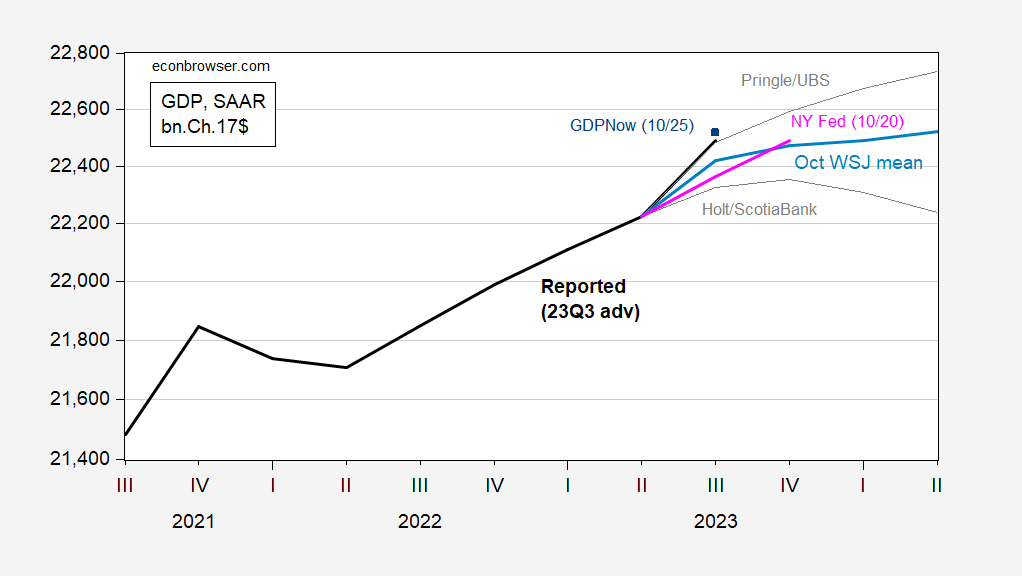GDP In Q3: Relative To Nowcasts, And Alternative Estimates
GDP surges, at 4.9%, compared to 4.3% Bloomberg consensus, and 5.4% from the Atlanta Fed’s GDPNow (It’s about a point less than the seemingly over-optimistic GDPNow of two month’s ago (8/24)). Jim’s post yesterday discusses the implications for recession calls, as well as for the macrostabilization (inflation reduction to target). Here’s a picture of where the advance estimate placed GDP, relative to nowcasts and forecasts.

Figure 1: GDP 2023Q3 advance estimated as reported (black), WSJ October survey mean (blue), 20% trimmed range (gray lines), GDPNow (blue square), NY Fed nowcast (pink line), all in bn.Ch.2017$ SAAR. Source: BEA, WSJ, Atlanta Fed, NY Fed, and author’s calculations.
GDP is the expenditure side measure of output. As documented by CEA (2015) and Nalewaik and Braun (BPEA, 2011), GDO — the arithmetic average of GDP and GDI — is a more accurate measure of final GDP, with hGDP reverting more to GDO than otherwise.

Figure 2: GDP (blue), GDO (tan), and GDP+ (green), all in bn.Ch.2017$ SAAR. GDO assumes enterprise income falls $100 bn (SAAR) in Q3. GDP+ assumes 2019Q4 GDP+ equals GDP. Source: BEA 2023Q3 advance estimate, Philadelphia Fed (accessed 10/26/23), and author’s calculations.
Recalling that in as of July 2001, the initial read for Q2 GDP growth was positive (when NBER placed the business cycle peak at 2001Q1), it’s always important to remember that GDP is subject to substantial revision (which is why the NBER BCDC does put primary reliance on this measure). The mean absolute revision (from advance to final) of 1.2 ppts (SAAR), and standard deviation of revision (from advance to final) of 1 ppt. (The mean revision is 0 ppts, so advance estimates of growth are on average unbiased.)With a reading of 4.9 ppts, and a MAR of 1.2 ppts, a negative reading on Q3 GDP in the final vintage seems unlikely.
The Philadelphia Fed’s GDP+, which incorporates information from revisions, indicates Q3 GDP is 1.5 ppts (SAAR) less than the GDP measure. Nonetheless, given previously higher growth readings than GDP, GDP+ rebased to 2019Q4 GDP+ = GDP indicates output 0.6% less than the official reading.
More By This Author:
Strong GDP Growth And Consumer SpendingDoes The Confidence Index Say We’re In A Recession?
Consumer Spending Is Up, Saving Is Down. What Does This Mean For The Economy?



